
Journal of Science and Transport Technology Vol. 2 No. 3, 18-25
Journal of Science and Transport Technology
Journal homepage: https://jstt.vn/index.php/en
JSTT 2022, 2 (3), 18-25
Published online 29/09/2022
Article info
Type of article:
Original research paper
DOI:
https://doi.org/10.58845/jstt.utt
.2022.en.2.3.18-25
*Corresponding author:
E-mail address:
quynhanhbt@utt.edu.vn
Received: 02/08/2022
Revised: 24/09/2022
Accepted: 26/09/2022
Effect of several fillers on some basic
mechanical properties of asphalt concrete
Quynh-Anh Thi Bui*
University of Transport Technology, Hanoi 100000, Vietnam
Abstract: Filler is one of the mandatory ingredients in asphalt mixture. It also
plays a very significant role in influencing the properties and behavior of asphalt
concrete. This paper presents the results of laboratory experiments to determine
the influence of 4 different fillers (including conventional stone powder, Portland
cement, rice husk ash, and fly ash) on some mechanical properties of asphalt
concrete with Dmax of 12.5 (AC12.5). The content of filler used in the study was
5% of the total volume of aggregate. The results show that the designed AC with
different fillers have the mechanical properties (air void, Marshall stability, flow,
and retaining stability) that meet the specification requirements of Vietnam
Ministry of Transport Decision No. 858/2014. In which the mechanical properties
of AC using conventional stone powder filler are achieved with an overall better
and stable effect. Although rice husk ash and fly ash filler also have certain
improvements in Marshall stability and air void, AC using rice husk ash and fly
ash filler does not meet the requirement of elastic modulus recommended in the
Vietnam standard for flexible pavement design 22TCN 211-06.
Keywords: filler, rice hush ask, fly ash, cement, mechanical properties, asphalt.
1. Introduction
Asphalt concrete (AC) is a mixture of
aggregate, filler and bitumen with a certain grade.
The filler has importance role to influent on physical
and mechanical properties of AC [1]. As mixed with
bitumen, they create a mastic mixture with many
outstanding features such as increasing bond
between bitumen and aggregate, increasing
stability, increasing moisture durability and
reducing cracks [2–4]. Filler also interacts with
bitumen to form a mastic asphalt mixture that plays
a very important role in improving some properties
of AC [5]. Moreover, the filler particles fill the voids
in the AC mixture, leading to increase the density
and reduce the voids of AC [6,7].
Thus, to improve the properties of AC, one of
the measurements is to find a way to replace the
convention mineral filler (stone powder) by other
filler [1],[8]. The use of cement as a partial
replacement of mineral powders in the production
of asphalt mixes has been reported and that have
brought some positive results such as improved
rutting and fatigue resistance [9], bond between
bitumen and aggregate [10], stiffness [11].
In addition, fly ash, an industrial waste (from
thermal power plants) and rice husk, an agricultural
by-product, which annually releases huge mass
(millions of tons) but have not been properly utilized
[12,13]. Studies show that rice husk ash formed by
burning rice husks under suitable conditions has a
very large porosity and contains mainly SiO2 oxide
equivalent to the content in silica fume [3,8,14,15].
Fly ash is a mixture of aluminum oxide, calcium
oxide, silica oxide, and iron oxide. Both fly ash and
rice husk ash is suitable as a mineral admixture for
concrete due to high pozzolan activity [16–18]. In

JSTT 2022, 2 (3), 18-25
Bui
19
the world, there have been a number of studies on
applying fly ash and rice husk ash into AC to
improve some its mechanical properties such as
indirect tensile strength [3],[15], moisture durability
[14], Marshall stability [18],[19]. In Vietnam, there
have been some initial studies of evaluating some
types of fillers such as fly ash, cement on basic
properties of asphalt mixture such as Marshall test,
direct tensile test, wheel tracking test [9],[17]. The
results show that it is possible to replace the
traditional mineral powder material with these fillers
which can produce AC. Le et al. [8] conducted a
investigate using SiO2 nano made of from rice husk
ash as an additive (not filler) to asphalt concrete. It
was indicated that rice husk ash additive can
increase Marshall stability as well as reduce wheel
rutting for asphalt concrete. However, at present,
there is no study comparing the possibility of using
Portland cement, fly ash and rice husk to replace
stone powder in asphalt mixture under Vietnamese
conditions.
Therefore, in this paper, the possibility of
using cement, fly ash and rice husk ash as filler to
replace conventional stone powder was evaluated
through some basic mechanical parameters such
as elastic modulus, air void, Marshall stability, flow,
and retaining stability of asphalt concrete with Dmax
of 12.5 (AC12.5).
2. Materials and mixture design
2.1. Experimental materials
Aggregate (crushed stone D19, D12.5,
D4.75) that was taken from Dong-Ao quarry,
Thanh-Liem, Hanam satisfied the technical
requirements of TCVN 8819:2011 [20] and
Decision QĐ-858/2014 [21].
Bitumen 60/70 that was supplied by
Petrolimex JSC met the requirements of TCVN
7493:2009 [22] and Circular No. 27/2014/TT-
BGTVT [23].
The 4 fillers used in the study include:
(1) Mineral stone powder (SP) was given
from Kien-Khe, Hanam met the requirements of
TCVN 8819-2011 [20].
(2) Cement Hoang-Thach PCB30 (PC)
satisfied the requirements of TCVN 6260:2009 [24]
was used.
(3) Rice husk ash (RH) is prepared by
burning rice husk, after burning rice husk ash is
finely ground by ball mill grinder for 30 minutes.
(4) Fly ash (FA) was be origin from Pha-Lai
thermal power plant has been treated by
dissociation blowing technology of Vina F&C fly
ash factory. The fly ash is equivalent to group F
according to ASTM C618-03 [25].
The photos of some fillers in the study are
shown in Fig 1.
Fig 1. Types of fillers (a) FA, (b) SP, (c) PC,
(d) RH
2.2. Mixture design
Mixture AC12.5 is designed according to
Marshall method and satisfying Decision 858/QĐ-
BGTVT [21].
The aggregate mixture includes 18% D19,
37% D12.5, 40% D4.75 and 5% filler. Aggregate
grading distribution of AC12.5 after mixing is
shown in Fig 2.
AC12.5 mixture consisting of aggregate,
filler, bitumen 60/70 was mixed according to the
designed ratio with the aggregate grade as
described above and the bitumen content
accounted for 4.9% by weight of dry aggregate.
Fabrication of AC12.5 samples with variable
fillers including SP, PC, RH, and FA to conduct
experiments. The process of mixing AC samples
using different fillers is similar to AC using mineral

JSTT 2022, 2 (3), 18-25
Bui
20
fillers. The experimental plan is shown in Table 1.
The Marshall specimens is illustrated in Fig 3.
Fig 2. Aggregate grading of AC12.5
Table 1. The experimental plan
Experiment
Number of specimens
(sps)
1
Marshall Stability,
flow and retaining
stability
3 sps * 2 cases * 4 fillers
= 24 sps
2
Air void
3 sps* 4 fillers = 12 sps
3
Elastic modulus
3 spes * 4 fillers = 12 sps
Fig 3. Marshall specimens
2.3. Experimental program
(1) Marshall Stability, flow and retaining
stability test
Marshall stability and flow are performed
according to the standard TCVN 8860-1:2011 [26].
Cylindrical AC sample of specified size (101.6 mm
diameter and 63.5 mm height) was immersed in a
water bath with thermostat at 60oC during 40 mins
or 24 h. Then the cured samples are tested under
the Marshall machine (Fig 4) with constant
displacement. The maximum compressive force
value is the Marshall stability while the recorded
strain at the same time is the Marshall flow.
Marshall stability and flow are very important
criteria for design, construction and acceptance of
AC pavement.
Fig 4. Marshall machine
Retaining stability of asphalt concrete (R, %),
is one of the criteria for the design and quality
control of AC, is used to evaluate the influence of
water on AC. Retaining stability was determined
according to TCVN 8860-12:2011 [26]. Retaining
stability of asphalt concrete can be calculated by
the follow formula:
R= Sa
S×100%
(1)
Where: S is the Marshall stability of AC
sample immersed in a water bath at 60°C for 40
min; Sa is the Marshall stability of AC sample
immersed in a water bath at 60°C for 24 h.
(2) Air void test
Air void (Va, %) is the total volume of air voids
between aggregate particles coated by bitumen in
the compacted AC mixture. The air void was
determined based on the maximum density of
loosed AC and the bulk density of compacted AC
(Fig 5). Air void test was carried out according to
TCVN 8860-9:2011 [26]. The air void of the AC

JSTT 2022, 2 (3), 18-25
Bui
21
mixture is one of the criteria used in the design of
the mix and the assessment of the level of
compaction at the site.
Fig 5. Air void test
(3) Elastic modulus test
The elastic modulus of the flexible pavement
structure is the deformation resistance property of
the pavement structure that includes the surface
and the effective area under the effect of standard
wheel loads. The elastic modulus of pavement
structure is one of important criterion of design
criteria of pavement structure. The elastic modulus
(E, MPa) is determined according to Appendix
C.3.1 of 22 TCN 211-06 [27]. The test sample is a
cylindrical size 100x100 mm, immersed in a
thermostatic water tank at the test temperature
(30oC) for at least 2.5 h. The displacement rate of
0.01 mm/min was kept constant during the test.
The elastic modulus is determined by the following
formula:
E= 4P.H
π.D2
(2)
Where: D is diameter of specimen (mm); H is
sample height (mm); P is load (kN).
3. Results and discussion
3.1. Marshall Stability
Fig 6 shows the results of Marshall stability
tests for AC sample using different filler types
immersed in 60 °C water at 40 min and 24 h. The
results show that all AC samples satisfy the
Marshall stability requirements of 858/QD-BGTVT
[21] (greater than 8 kN). In which, the Marshall
stability value of AC using RH (13.32 and 12.94 kN)
is the highest while that of FA is the lowest (9.35
and 8.63 kN). Using RH filler can improve Marshall
stability about 3.5% (in case of 60oC/40min) and
3.1% (in case of 60oC/24h). However, using PC
and FA filler reduces Marshall stability compared to
conventional SP filler about 2.6 and 5.2 % (in case
of 60oC/40min) and 2.7 and 5.7% (in case of
60oC/24h), respectively.
Fig 6. Marshall stability result
3.2. Marshall Retaining stability
The results showing the Marshall Retaining
stability of the samples are shown in Fig 7.
Fig 7. Result of Marshall Retaining stability
The results show that the Retaining stability
of the AC sample using SP is the highest (93.1%),
and the Retaining stability of the both AC samples
using RH and FA filler is approximately the same
and the lowest (91.4% and 91.2%, respectively).
All samples have the Retaining stability of meeting
the technical requirements according to 858/QD-
BGTVT [21] (greater than 80%) and according to
TCVN 8819-2011 [20] (greater than 75%).
It can be seen that the replacement of
conventional fillers also decreases the Retaining

JSTT 2022, 2 (3), 18-25
Bui
22
stability of AC, although this reduction was not
significant. Specifically, compared with AC using
conventional SP, AC using PC, RH and FA filler
has reduced stability by 0.53%, 2.1% and 2.2%
respectively.
3.3. Marshall flow
The results of the Marshall flow test for the
AC sample using different filler types are shown in
Fig 8. The flow values of all AC satisfied the
standard 858/QD-BGTVT [21] (1.5-4mm). The flow
value of AC using RH filler is the highest (3.88 mm),
while PC filler bring the lowest flow value (2.67
mm).
It can be seen that when using RH filler, it
helps to increase flow (about 19.8%) compared to
using conventional SP filler. In contrast, using PC
and FA reduced flow (about 17.6% and 6.17%
respectively). This shows that the rice husk ash
filler has more dispersing effect.
Fig 8. Result of Marshall flow
3.4. Air void
Fig 9 shows the air void of AC samples using
different filler types. The results show that all the
AC samples satisfy the technical requirements of
TCVN 8819:2011 [20] (3-6%) and 858/QD-BGTVT
[21] (4 - 6%). However, the air void of the samples
using RH filler was the highest (5.52%) and the FA
filler was the lowest (4.96%).
Compared with SP filler, both PC and RH
filler have higher air void which is 4.5% and 9.74%
higher, respectively. In contrast, AC using FA filler
reduced the air void by 1.4% compared with that of
SP filler.
Thus, using FA filler replacing SP filler can
get a little reduction the air void of AC that makes
AC mixture denser. On the contrary, using PC or
RH filler increase the air void.
Fig 9. Result of air void
3.5. Elastic modulus
The results of elastic modulus at 30oC of AC
using different filler types are shown in Fig 10. The
results show that AC using SP filler has the highest
elastic modulus (436 MPa) and the AC using FA
filler has the lowest (406 MPa). It can be seen that
using PC, RH and FA filler reduces elastic modulus
as compared with SP filler about 3.5%, 8.14% and
6.4%, respectively. According to the specification
in 22TCN 211-06 [27], the elastic modulus at 30oC
of AC (with crushed stone content greater than
50%) must be higher than 420 MPa. Thus, AC
using SP and PC meet the requirements, while RH
and FA do not meet this requirement.
Fig 10. Result of elastic modulus



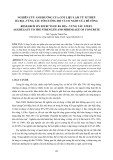
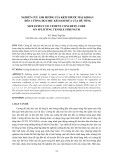
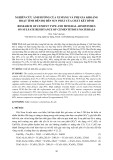
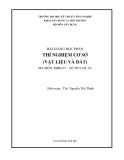



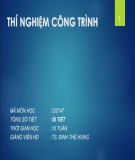

![Bài giảng Quản lý vận hành và bảo trì công trình xây dựng [chuẩn nhất]](https://cdn.tailieu.vn/images/document/thumbnail/2025/20251006/agonars97/135x160/30881759736164.jpg)









![Ngân hàng câu hỏi trắc nghiệm Sức bền vật liệu 1: [Mô tả/Định tính Thêm để Tăng CTR]](https://cdn.tailieu.vn/images/document/thumbnail/2025/20250920/kimphuong1001/135x160/6851758357416.jpg)


![Trắc nghiệm Kinh tế xây dựng [chuẩn nhất]](https://cdn.tailieu.vn/images/document/thumbnail/2025/20250920/kimphuong1001/135x160/32781758338877.jpg)
